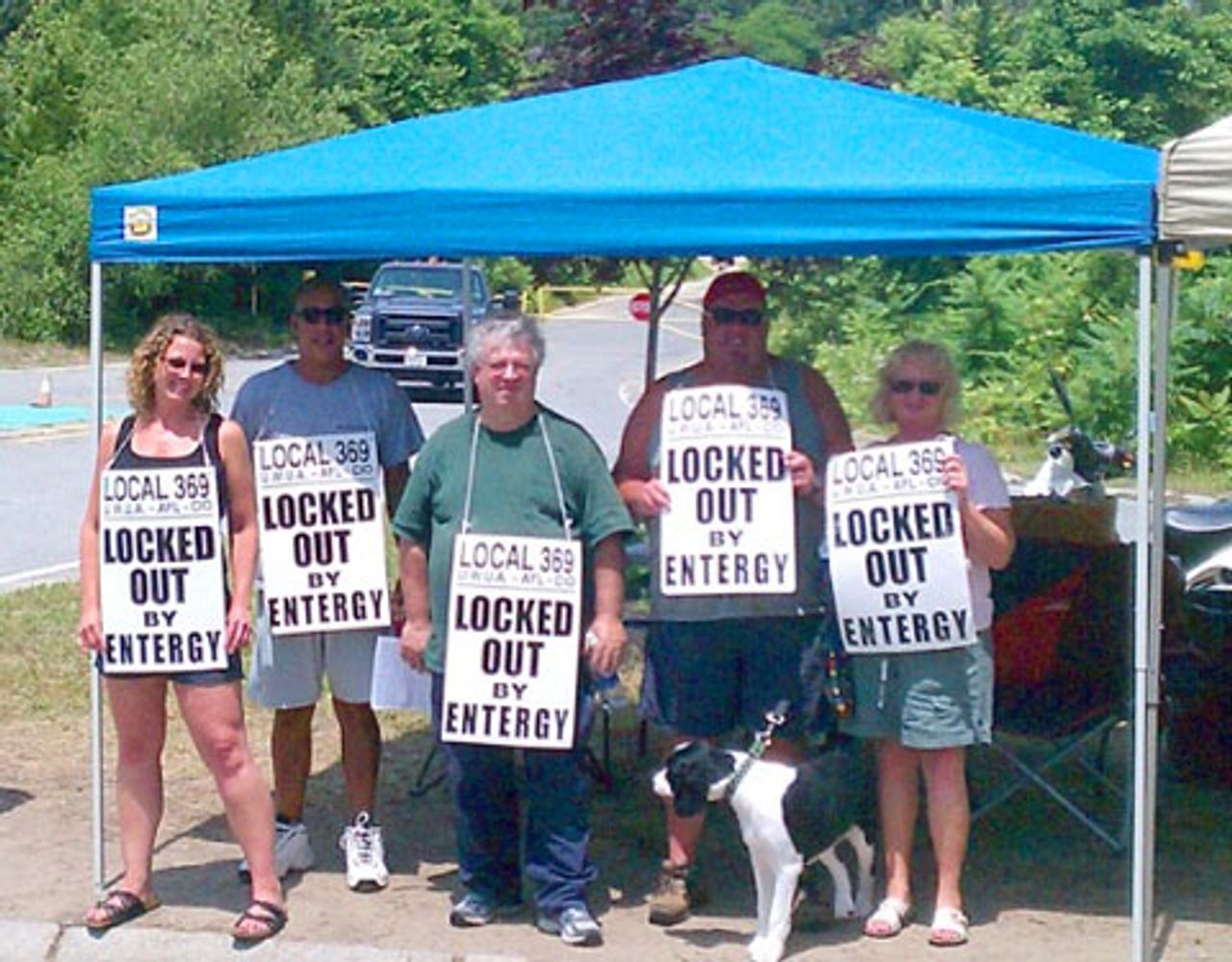 Locked-out Pilgrim power plant workers
Locked-out Pilgrim power plant workersA press release issued by Local 369 of the UWUA (Utility Workers Union of America) June 29 stated that Entergy Corporation was preparing to end health care coverage for over 240 locked-out power workers at midnight on Saturday, June 30. The Pilgrim Nuclear Power Station workers in Plymouth, Massachusetts have been locked out by Entergy since June 6.
The press release quotes UWUA Local 369 President Dan Hurley: “This is a supremely cruel gesture from a company that is tone deaf to mounting safety concerns, unbending on basic contract fairness, and now unconcerned that families who rely on them for vital healthcare will be left with nowhere to turn.”
 Balloon set up outside Entergy’s Pilgrim Nuclear
Balloon set up outside Entergy’s Pilgrim NuclearPower Station
The statement continues: “UWUA Local 369 spent nearly two months negotiating with Entergy over key healthcare, safety and staffing issues before they were locked out by the company on June 6. An offer with severe cuts to employee health coverage and other provisions that would hurt worker families was rejected by Local 369 members on June 20.”
The contract rejection by the workers was in opposition to the unanimous recommendation for its acceptance by the union bargaining committee. The 137-89 rejection June 20 was the second such vote, following the rejection by a 174-32 margin of an earlier contract that was the same in all essentials. It was following this vote that management escorted the workers off the premises when the old contract expired on June 5.
The latest move by management to cut off health benefits is clearly aimed at intimidating the workers in preparation for any further contract vote. Workers on the picket line at Pilgrim told the WSWS that Entergy had also been attempting to slow down unemployment payments in order to make it more difficult for workers to resist.
“I think they intended to give us a lousy contract and put us in a position where we could accept it or be out,” one worker said. “That’s really all there is to it. From what I understand the union has contacted them a number of times and they haven’t got back to us yet.”
A number of workers said that the lockout continued to win “incredible support” from the local community and other workers. “The whole community supports us,” one said.
A union steward on the picket line told the WSWS, “They are trying to take away the health care so that we are more likely to cave in. They are blocking unemployment so we don’t get that in a timely manner. If you don’t have money coming in and you don’t have health care, you are more likely to cave in at the bargaining table, but that’s not our plan.”
“Management keeps lying in the press,” he added, “saying that they’ve been waiting for the federal mediator. But there has always been a federal mediator assigned supposedly and our union keeps asking, sending letters on a daily basis, asking them to return to the table, but nothing has materialized. The company is calling this a cooling-off period. So we are out here—no money, no health care—so that puts them in a better position at the bargaining table.”
While issuing a mandate for other members of the local to join the picket line outside the Pilgrim plant, the union has done nothing to facilitate any meaningful mobilization of other workers behind those locked out. The union response to the suspension of health coverage is to step up its begging to be allowed to return to the negotiating table. They have recommended a contract numerous times to the membership that Local President Hurley later acknowledged demanded “cuts to their pay or health care from a company making record profits and paying executives in the tens of millions.”
Workers from electric utility NStar, who are also organized in Local 369, have turned out on the picket line to support the locked-out workers. One told the WSWS, “I work for NStar so I’m here supporting them.”
When asked his opinion of the contract agreed with NStar on June 11—less than a week into the Entergy lockout, which management boasted was “consistent with industry changes”—he said, “Nothing much really changed for us, but medical benefits did get worse. This is the same for everyone else, so that’s why we accepted the contract.”
The NStar contract pushed through by the union reportedly provides annual wage increases of only 3 percent, 2.75 percent and 2.5 percent over three years, respectively, and eliminates defined retirement benefits for new hires.
Another NStar worker was more critical of the contract that had been accepted. Referring to the people still working at the Pilgrim plant he said, “Some of those guys belong to our union. When I came down here I called a board member of mine and said, ‘I don’t understand, we are 369. How can our personnel be allowed to go in there? Either we all work or we all go out.’”
He added, “The response was that before they took over, the last regime in the union put something special in the contract saying that if they do a lockout, X amount of personnel must maintain the nuclear power station. I said I still don’t understand. If they have to maintain their power station they can ship people in from the government if they are having problems.
“They have governmental people to run this stuff, just like they did with the airports. They have their people if they have to do that. None of our guys should be in there.
“The official said, when the union gave the contract, if they don’t agree to it they will fire them. So I said: Well, let them fire them. They can tell you all they want they are going to fire you, and they can fire you, but you can get your job back within 30 days if there is a settlement. If that happened the union could pull out NStar, pull out everybody. They still never clarified it.”
The fact that members of the same local are working at Pilgrim while fellow union members are locked out is not simply the result of bad negotiations by a previous union regime. For more than three decades the unions have overseen one betrayal after another, beginning with the destruction of the air traffic controllers union PATCO in 1981. Verizon workers who went out on strike last year were led back to work by the Communication Workers of America without a contract and continue to work without one a year later.
If the Pilgrim workers are to end their lockout without a complete capitulation to the demands of management, this struggle must be taken out of the hands of the union leadership. Rank-and-file committees must be formed with the aim of mobilizing broad sections of workers behind the locked-out power workers.
This mobilization should begin with the more than 3,000 utility workers in Massachusetts represented by Local 369, which includes 1,850 workers at NStar, delivering electricity and natural gas to 1.4 million customers in the eastern and central parts of the state. The union also organizes workers at National Grid and other power companies across the region. Taken as a whole, the membership of Local 369 represents an important force, which if mobilized could transform the character of the contract negotiations at the Pilgrim plant.
